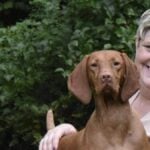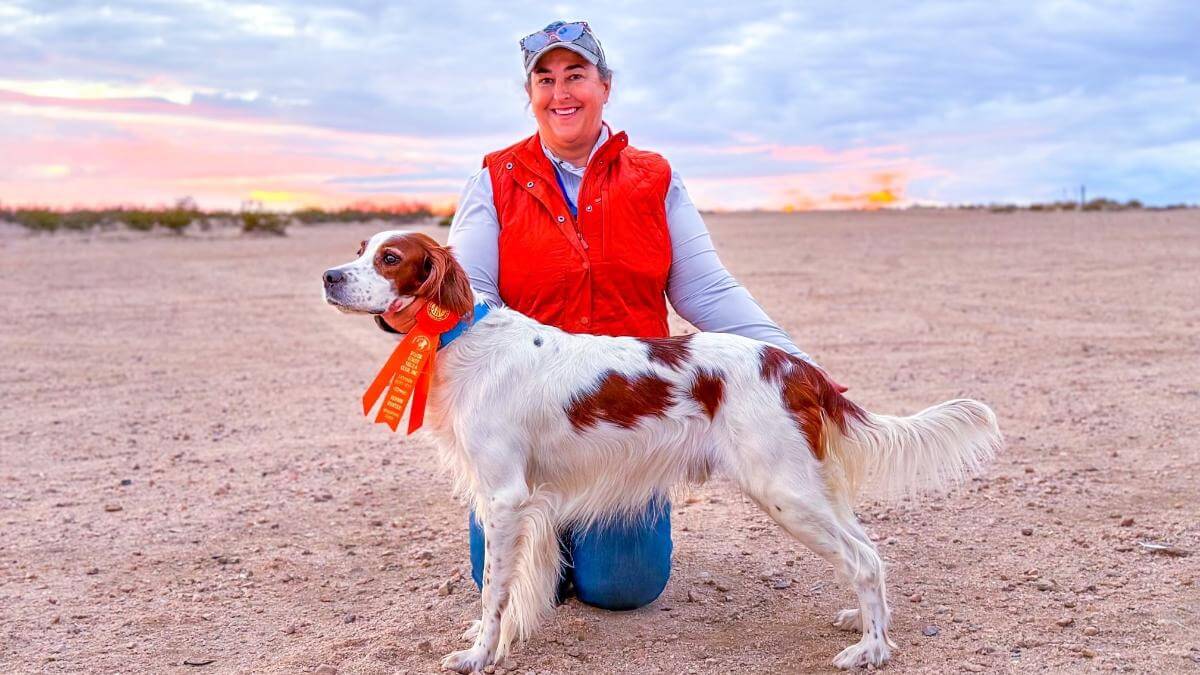
Home » Lisa Montgomery | Renegade Irish Red and White Setters

Lisa Montgomery
1. I’m Lisa Montgomery, and I’ve been involved with purebred dogs since 2016 when I got an Irish Red and White Setter (IRWS) who turned my life upside down and started an adventure that I would never have guessed existed. Because I stepped into the ring and the field with him, I’ve gotten a hunting license, gotten a couple of other pointing breeds, competed across the West Coast of the US with my boy to help him become the only IRWS to earn a Master Hunter Advanced title, been an invitee to Westminster, earned my credentials to judge pointing breed Hunt Tests, and founded my own kennel, Renegade.
2. For Irish Red and Whiter Setters, like all of the Sporting breeds, their raison d’être is to hunt. And they should do so with fluid power and joy. Our Breed Standard uses the phrase “athletic rather than racy” to describe them. They should have sufficient substance to hunt all day, but not so much that they are ever slow.
There is a misconception that their coat should be 60 percent white and 40 percent red. Neither AKC nor intentional Standards include such proscription, and instead focus on the structural needs to fulfill their purpose. A strong rear drive and fluid, efficient movement are much more important than a specific division of coat color.
3. I think it is always challenging to find quality homes. Having a lesser-known breed (the Irish Red and White Setter dropped to 170 on the list of registrations for 2024) makes it more challenging.
4. I think the technology space that we breeders most watch is genetics and assisted reproduction. I try to stay current with what research institutions like UC Davis Veterinary Genetics and Laboratory and Cornell Canine Genetics Research Laboratory are doing, and I hope to see more of this research translate into actionable information so that breeders can make more informed choices and continue to improve the long-term health of the breeds we so love.
As far as communications, I’ve never been a fan of social media, but I maintain a website where I try to include not just information about my dogs but general educational information on AKC events health testing as well. And although I personally am more of an introvert, my dogs are not, and so my Red and Whites have an Instagram account.
5. This is such a hard question to get a handle on. When my dogs and I are out and about and meet people in person, the interactions are positive as people are interested in the unique breeds. This has been a consistent experience over time. But when one explores the online space, that is usually a different experience, and as more people spend more time online, the misinformation is challenging to counter. The myth of “hybrid vigor” is alive and well. The “adopt-don’t-shop” crowd seemingly has little interest in the distinction between careless breeding and preservation breeding. And it feels like this kind of misinformed, black and white thinking has had an impact on the increase in anti-breeder legislation that is being introduced across the country.
6. Unfortunately, there are challenges and they are challenges without easy answers. I think we are all aware of the aging population in dogs, and that impact is felt across all facets. In pointing breed Hunt Tests and Field Trials, and we have lost some of the pillars of the sports in the last couple of years. Our judging pools are shrinking and clubs have fewer members to help host field events. A different concern is that we are losing access to the grounds to hold Hunt Tests and Field Trials, and these challenges mean there are fewer opportunities for our dogs to prove their abilities and do what they love.
7. I think the work done to drive the increased participation in Companion activities is good. Anything that gets people engaging with their dogs in ways that enhance the dogs’ and the bipeds’ physical and mental well-being is great. Also, the adjustment to the Junior Showmanship rules that allows Juniors to show dogs they don’t own is a positive, as it lowers a potential barrier to entry and allows those Juniors to explore more breeds than they might otherwise have been able to explore previously. Additionally, I hope both efforts get continued attention and are seen as ways to encourage more owners, Juniors, and enthusiasts to explore the Performance sports.